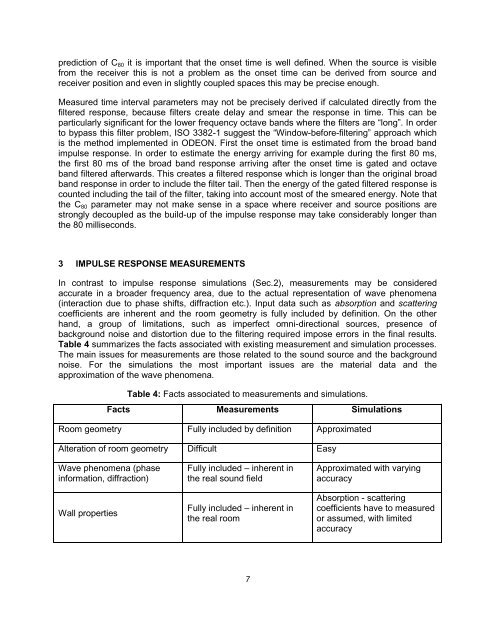paper - Odeon
paper - Odeon
paper - Odeon
You also want an ePaper? Increase the reach of your titles
YUMPU automatically turns print PDFs into web optimized ePapers that Google loves.
prediction of C 80 it is important that the onset time is well defined. When the source is visible<br />
from the receiver this is not a problem as the onset time can be derived from source and<br />
receiver position and even in slightly coupled spaces this may be precise enough.<br />
Measured time interval parameters may not be precisely derived if calculated directly from the<br />
filtered response, because filters create delay and smear the response in time. This can be<br />
particularly significant for the lower frequency octave bands where the filters are “long”. In order<br />
to bypass this filter problem, ISO 3382-1 suggest the “Window-before-filtering” approach which<br />
is the method implemented in ODEON. First the onset time is estimated from the broad band<br />
impulse response. In order to estimate the energy arriving for example during the first 80 ms,<br />
the first 80 ms of the broad band response arriving after the onset time is gated and octave<br />
band filtered afterwards. This creates a filtered response which is longer than the original broad<br />
band response in order to include the filter tail. Then the energy of the gated filtered response is<br />
counted including the tail of the filter, taking into account most of the smeared energy. Note that<br />
the C 80 parameter may not make sense in a space where receiver and source positions are<br />
strongly decoupled as the build-up of the impulse response may take considerably longer than<br />
the 80 milliseconds.<br />
3 IMPULSE RESPONSE MEASUREMENTS<br />
In contrast to impulse response simulations (Sec.2), measurements may be considered<br />
accurate in a broader frequency area, due to the actual representation of wave phenomena<br />
(interaction due to phase shifts, diffraction etc.). Input data such as absorption and scattering<br />
coefficients are inherent and the room geometry is fully included by definition. On the other<br />
hand, a group of limitations, such as imperfect omni-directional sources, presence of<br />
background noise and distortion due to the filtering required impose errors in the final results.<br />
Table 4 summarizes the facts associated with existing measurement and simulation processes.<br />
The main issues for measurements are those related to the sound source and the background<br />
noise. For the simulations the most important issues are the material data and the<br />
approximation of the wave phenomena.<br />
Table 4: Facts associated to measurements and simulations.<br />
Facts Measurements Simulations<br />
Room geometry Fully included by definition Approximated<br />
Alteration of room geometry Difficult Easy<br />
Wave phenomena (phase<br />
information, diffraction)<br />
Wall properties<br />
Fully included – inherent in<br />
the real sound field<br />
Fully included – inherent in<br />
the real room<br />
Approximated with varying<br />
accuracy<br />
Absorption - scattering<br />
coefficients have to measured<br />
or assumed, with limited<br />
accuracy<br />
7
















